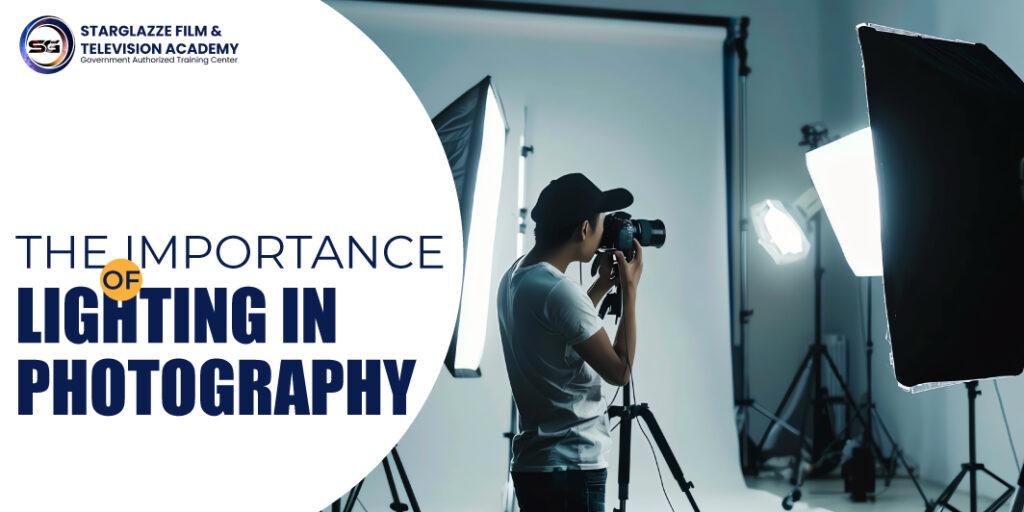Photography is an art form that revolves around capturing light. Whether you’re a seasoned professional or just starting a photography course, understanding the crucial role of lighting in creating captivating images is essential. Lighting isn’t just about making your subject visible; it’s about setting the mood, highlighting textures, creating depth, and bringing your creative vision to life.
In this comprehensive guide, we’ll explore the various aspects of lighting in photography, from natural light to artificial setups, and how mastering these techniques can elevate your work to new heights. Whether you’re interested in portrait, landscape, or product photography, the principles of lighting remain fundamental to achieving stunning results.
As you embark on your journey through photography, remember that lighting is both a science and an art. It requires technical knowledge and creative intuition. By the end of this article, you’ll have a deeper appreciation for the power of light and how it can transform your photographs from ordinary to extraordinary.
Understanding the Basics of Light in Photography
The Nature of Light
Before diving into lighting techniques, it’s crucial to understand the basic properties of light:
- Intensity: The brightness or strength of the light
- Color temperature: The warmth or coolness of the light
- Direction: Where the light is coming from relative to the subject
- Quality: Whether the light is hard (sharp shadows) or soft (diffused)
Mastering these elements is key to controlling the mood and impact of your photographs.
Types of Light Sources
Photographers work with various light sources, each offering unique characteristics:
- Natural light: Sunlight, moonlight, and ambient light
- Continuous artificial light: Studio lights, LED panels, and household lamps
- Flash: Speedlights and strobe lights
Understanding how to work with different light sources is crucial for adapting to various shooting situations. Photography classes often provide hands-on experience with these different light sources to help students become versatile photographers.
The Importance of Lighting on Composition
Creating Depth and Dimension
Lighting plays a pivotal role in creating a sense of depth in your images. By strategically placing lights or using natural light, you can separate your subject from the background, adding a three-dimensional quality to your photographs. This technique is particularly important in portrait and product photography.
Guiding the Viewer’s Eye
Skilled photographers use lighting to direct the viewer’s attention to specific areas of the image. By highlighting certain elements and casting shadows on others, you can create a visual hierarchy that guides the viewer through your composition.
The Role of Lighting in Different Photography Genres
Portrait Lighting
In portrait photography, lighting is crucial for flattering the subject and conveying emotion. Key techniques include:
- Rembrandt lighting
- Butterfly lighting
- Split lighting
Understanding these patterns is essential for creating compelling portraits.
Product Photography Lighting
Product photography requires precise lighting to highlight features and textures. Techniques include:
- Soft box lighting for even illumination
- Backlighting for transparent objects
- Light tents for small product shots
Many photography classes in Pune offer specialized modules on product photography due to its commercial importance.
Post-Processing and Lighting
Enhancing Lighting in Post
While it’s always best to get lighting right in-camera, post-processing can help enhance or correct lighting issues:
- Adjusting exposure and contrast
- Dodging and burning to refine light and shadow
- Colour temperature adjustments
Learning these skills is an integral part of modern photography education.
Creating Lighting Effects in Post
Advanced post-processing techniques can simulate complex lighting setups:
- Adding light flares
- Creating sun rays
- Simulating studio lighting on location shots
These skills can give your images a professional edge and are often covered in comprehensive photography courses.
Illuminating Your Photographic Journey
Mastering lighting is a lifelong journey for photographers. It’s a skill that requires technical knowledge, creative vision, and constant practice. Whether you’re capturing breathtaking landscapes, intimate portraits, or stunning product shots, understanding and controlling light will elevate your work to new heights.
Those looking to deepen their understanding of lighting and photography, consider enrolling in photography courses in Pune at Starglazze Academy. Our comprehensive programs cover everything from basic lighting principles to advanced techniques, preparing you for a successful photography career.
At Starglazze Academy, we offer some of the best photography courses, taught by industry professionals who bring real-world experience to the classroom. Our state-of-the-art facilities and hands-on approach ensure that you’ll learn the theory behind great lighting and gain practical skills that you can apply immediately in your work.
Whether you’re a beginner looking to start your photographic journey or an experienced photographer aiming to refine your skills, Starglazze Academy’s photography classes provide the perfect environment to grow and excel. Join us and illuminate your path to becoming a master of light and photography. Enroll today!

